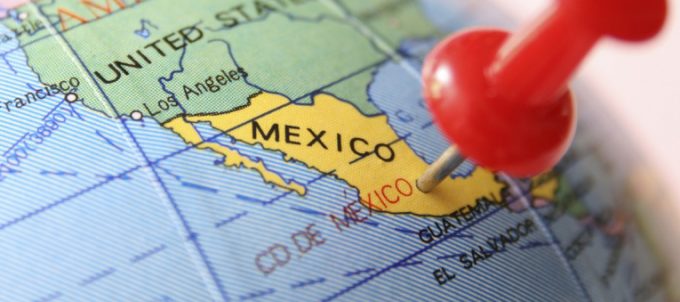Grape demand: carriers line up for a bite as South African export season begins
South Africa’s grape export season has begun, and ocean carriers are lining up for a ...
UPS: MULTI-MILLION PENALTY FOR UNFAIR EARNINGS DISCLOSUREWTC: PUNISHEDVW: UNDER PRESSUREKNIN: APAC LEADERSHIP WATCHZIM: TAKING PROFITPEP: MINOR HOLDINGS CONSOLIDATIONDHL: GREEN DEALBA: WIND OF CHANGEMAERSK: BULLISH CALLXPO: HEDGE FUNDS ENGINEF: CHOPPING BOARDWTC: NEW RECORDZIM: BALANCE SHEET IN CHECKZIM: SURGING
UPS: MULTI-MILLION PENALTY FOR UNFAIR EARNINGS DISCLOSUREWTC: PUNISHEDVW: UNDER PRESSUREKNIN: APAC LEADERSHIP WATCHZIM: TAKING PROFITPEP: MINOR HOLDINGS CONSOLIDATIONDHL: GREEN DEALBA: WIND OF CHANGEMAERSK: BULLISH CALLXPO: HEDGE FUNDS ENGINEF: CHOPPING BOARDWTC: NEW RECORDZIM: BALANCE SHEET IN CHECKZIM: SURGING

Frustrated with infrastructure limitations that hamper the ability of Mexican ports to absorb the rise in traffic, ocean carriers are looking to the new government for fresh impetus, particularly at the nation’s premier Pacific gateway.
Frustration has been building among the carriers over problems at Mexican ports, claiming they undermine the nation’s ability to absorb the influx of new business from the near-shoring trend, of which Mexico is one of the chief beneficiaries.
At the recent annual congress of AMANAC, the association of Mexican shipping agents, speakers described the situation as disastrous, and called for action to increase capacity, especially at the port of Manzanillo, the largest gateway for international freight moved by ocean carriers.
According to one source, ships may wait up to five days to get unloaded at major Mexican ports. Javier Moreira, country manager for CMA CGM, said the system was “inefficient” and he was surprised how much his company is paid for delays in a year.
Torsten Nolting, VP Mexico at Hapag-Lloyd, described the logistical inefficiencies as “a disaster”.
Rapid growth in traffic has overwhelmed port infrastructure. In the first eight months of this year, the nation’s ports handled 6,221,334 teu, an increase of 14.8%
Lazaro Cardenas saw the biggest surge, with throughput up 34.9%, to 1,586,838 teu, followed by Veracruz, the nation’s top east coast gateway, with a 16.5% rise, to 884,682 teu. At Manzanillo, throughput rose 8.5%, to 2,602,946 teu, with imports up 15.4%.
Manuel Fernandez Perez, director general of SSA Marine Mexico, said this was an opportunity for sustainable growth for the ports, noting that 35% of Mexico’s imports arrive by ocean carrier.
However, the ports are now choke points, with marine infrastructure overwhelmed by the rise in traffic, so urgent upgrades are needed, carrier executives stressed.
This requires more collaboration between stakeholders, but first of all, it needs more investment.
“Mexico is falling behind,” warned Patricia Perez, director general Mexico of Maersk. International organisations have recommended nations spend about 4% of GDP on infrastructure, but Mexico is only investing 3%, she noted.
Not surprisingly, much of the attention is on Manzanillo. Delegates at the conference called on the incoming administration in Mexico City to make the development of capacity one of its principal projects.
Back in 2019, the Office of Communication and Transport (which has since been restructured) released a paper outlining considerations in the government to expand capacity at Manzanillo. This included the construction of five new terminals in the Bay of Cuyutlan, including a container facility capable of handling 1.75m teu a year.
There have been no updates or further details since then. According to one observer, it has been an open secret that there has not been much interest in logistics development in the current government. Now, some hope president-elect Sheinbaum will show more interest.
Some have also suggested the government make personnel changes in ASIPONA, the administration of the national port system. At AMANAC, Julieta Juarez, administrative director of ASIPONA Manzanillo, said the imminent opening of new road access to the northern area of the port would boost capacity to serve trucks from the current 1,000 a day to 6,000, and that new x-ray equipment would cut down inspection times from five minutes to 1-1/2 minutes. She added that the implementation of the Safe Smart Platform as a single window had streamlined information exchange between users and ASIPONA.
Elsewhere ASIPONA Manzanillo recently argued that the presence of 15 vessels at anchor at the port (including two containerships, which had arrived behind schedule) was not a reflection of saturation of the port, but that Manzanillo “is and always will be one of the principal destinations of the world”.
Comment on this article